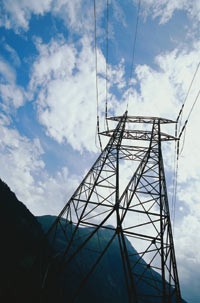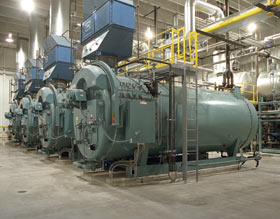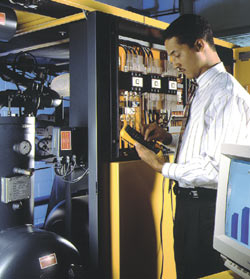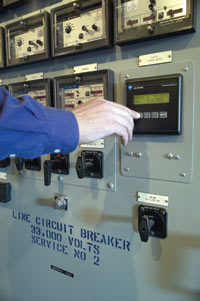
Unfortunately, he can’t. Price elasticity has arrived with a vengeance, making projections of long-term costs and therefore the payback from technology investments for gas turbines, reciprocating engines, waste burners and boilers extremely difficult to determine. But as a general rule, the cost of fuel is up, the price of electricity is down, and the ROI for capital-intensive CHP projects isn’t what it needs to be.
The California energy crisis two years ago dramatized the issue of energy availability. It also underscored the region’s need for greater power-generation capacity and created a friendly environment for CHP. The California Self-Generation Incentive Program promised to chip in up to 30 percent of the cost of micro-turbines and gas turbines that could generate up to 1 MW of electric power while utilizing a waste-heat recovery system. The stage was set for expanded CHP in food processing and other manufacturing industries.
California Natural Products, a Lathrop, Calif., processor of rice-based ingredients and low-acid aseptic products, was among the firms to take advantage of the program. The company’s new on-site CHP system came online last month and is expected to reduce electricity costs 20 percent. But natural gas prices are up sharply since the project began, and that has adversely affected the operating costs of the 1,350 kW Deutz natural-gas engine at the heart of California Natural’s system. “If I had to go out and buy this system today, I couldn’t,” reports Pat Mitchell, the company’s CEO. He projects a four-year payback on the project.
The system, engineered and designed by JST Energy of California and featuring controls from Encorp Inc., Windsor, Colo., generates 1.3 MW of electricity, less than half of the plant’s requirements. It also supplies steam for rice processing, the original activity at the 23-year-old company. In the last eight years, California Natural has added 12 aseptic low-acid lines to the mix. An uninteruptible power supply (UPS) to those lines was the critical factor in signing contracts for CHP three years ago, Mitchell explains.
“If we lose power for as little as 0.6 seconds on the low-acid lines, we’re looking at five hours of downtime,” he says. The company installed an 800 KW UPS system four years ago, and the new CHP system supports that hedge against brownouts. The UPS typically kicks in once every one to two weeks, he adds.

Off-the-shelf solutions
If CHP is to gain wider adoption, cogen supporters say, shorter depreciation schedules, tax credits and utility regulations that are more CHP-friendly are needed. Another is state and local permitting processes that would facilitate plug-and-play energy-generation systems. Customized engineering adds considerable cost, especially relative to the price of smaller systems.As it is, CHP units are approaching off-the-shelf status. “A lot of engineering has become standard,” according to Ken Peters, sales director at Atlanta’s Vericor Power Systems. “If a firm can put a boiler in, that same company can install a cogen plant. It’s not rocket science.”
A unit of Daimler Chrysler, Vericor has served the industrial power-generation market for 30 years under a variety of corporate banners, including Honeywell and Allied Signal. Meat processing, beverage manufacture, vegetable processing—“almost anyplace where there is a need for heat”—are candidates for CHP, Peters maintains, and he believes the food industry will reassert itself in the cogen market. “As time goes on and gas-produced electricity becomes more of a factor in power capacity, you will see the prices of gas and electricity run in parallel,” he predicts.
Vericor’s objective is to provide a payback from an onsite power system in three to five years. That’s an unacceptably long timeline for many prospective users. For them, a build/own/operate relationship makes more sense. Third-party hosting moves CHP from a capital project to an expense scenario. If the age and condition of existing boilers and other infrastructure is advanced, so much the better. “The viability of getting financing is tied to the health of the host,” Peters emphasizes. Growing companies that are fiscally sound stand the best chance of attracting a build/own/operate partner.
That describes Alto Dairy Cooperative, a Wisconsin cheese processor with plants in Waupon and Black Creek. The company outsourced ownership and operation of its steam plant last May to Alliant Energy Integrated Services, a Cedar Rapids, Iowa-based energy services company. The dairy’s three 1960s-vintage boilers in Waupon were replaced by four firetube boilers. The new units have a capacity of 68,000 lbs. of steam per hour, double the dairy’s typical demand.
“Efficiency wise, those three 600 HP boilers really struggled,” recalls Hans Horetzke, Alto’s director of engineering. “We were projecting a 3 to 4 percent improvement with the new 800 HP Cleaver Brooks boilers; instead it’s been 5 to 7 percent. Anytime you can upgrade your equipment and lower your cost, it’s a very good project.”

The project also made sense for Alliant, which was able to secure a long-term contract with Alto as a result. Unfortunately, the economics didn’t favor a CHP solution. “I’d love to have a cogen plant because then I’d be energy independent, but a cogen plant in this day and age is a hard sell,” concedes Horetzke.
That’s unfortunate, given the state’s energy outlook. Despite its rural image, Wisconsin boasts an eastern corridor that is home to an expansive industrial base. The state already imports 15 percent of its electricity, and only three large distribution lines exist to import power from surrounding states. The outlook is grimmer than California’s.
“Steam is still one of the most efficient and sanitary ways to heat your product,” Horetzke says, but electricity also is needed. The Waupon dairy maintains 8 MW of backup generation capacity for periods when electricity is interrupted, and those periods figure to become more frequent.

Affordable efficiencies
Outsourcing steam generation may be the industry’s best option for boiler upgrades. “That equipment is so capital intensive,” laments Tim Seely, president of the Gwaltney division of Smithfield Foods Inc. “It would be 20 years to get a payback on new boilers at five plants.”Instead, the pork processor is concentrating on conservation strategies with low capital thresholds and high potential paybacks. Water and sewer costs are an example. “We were pushing 2 million gallons of water used a day. Water and sewage costs were becoming significant,” recalls Rob Bogaard, vice president, operations at the Smithfield, Va., firm. Monthly task force meetings produced a strategy of high pressure, low water volume washdown procedures to curb escalating use. “We’ve been able to bring consumption down to the 1.8 million gallons range, despite growth in production,” says Bogaard.
Gwaltney’s parent corporation is building a $20 million biofuel plant in Utah to convert swine waste to biodiesel. If the high-profile project succeeds, similar plants likely will be built in North Carolina. That will mean fewer dollars for other energy and utility management projects, and greater emphasis on projects like water-use reduction. The primary costs of those types of efforts are staff time to capture data and measure performance. “Our engineering department has spent a huge amount of time and effort on capturing heat that used to go up the chimney,” Seely says. What those efforts lack in razzle-dazzle, they more than make up for in cold hard savings.
Energy consumption tracking is another time-intensive pursuit that is becoming commonplace in food plants, according to Al Hamdan, marketing director of energy consulting services at Rockwell Automation. Data logging is tedious, time-consuming and error prone work, though, which is why many plants are considering deployment of load profiling systems.
“People think it’s hard to get a handle on energy use, but that’s a misconception,” says Hamdan. “In food and other heavy process industries, there always is an opportunity for savings, usually in the order of 10 to 15 percent.”
Power monitoring devices are the backbone of a load profiling system, and their level of sophistication is moving inversely to price. The parameters measured typically include voltage, current, frequency, power factor and other quantity and quality dimensions. One client deploys 65 monitors in a massive facility, and the hardware cost tops $200,000. More typically, a handful of buses bear monitoring, and total system cost is in the $10,000 to $15,000 range.
Portable monitors are available, but they are pricey. They also fail to track long-term patterns and sporadic changes. For example, Hamdan says line surges and other disruptions in electric quality entitle customers to penalties or other compensation, but unless monitoring devices record those disruptions, the opportunity is lost.
HMI energy management software is crucial for gathering and analyzing data from the monitors, and the prevalence of Allen Bradley controls in food plants gives Rockwell’s software a leg up in integration, he adds. And while most plant managers prefer to manage their energy information internally, “some customers are saying, ‘Put the monitoring devices in my plant, put the database in your facility,” he says. For that segment, Rockwell recently introduced RS Energy Metrics, a Web-enabled package that provides a window to the plant via a standard browser.
Pumps, fans and compressors are the principal utility consumers in process industries, and initiatives like the U.S. Department of Energy’s Motor Challenge have made significant inroads into boosting efficiency rates for the first equipment two groups. Compressors are another matter. That’s beginning to change, however. Now that the holes have been plugged in hoses that made some facilities sound like snake pits, attention is shifting to compressor optimization.
“In probably 75 percent of plants, the design criteria was to oversize the compressor system,” estimates John M. Zaimis, application engineering manager at Kaeser Compressors Inc. “With a compressor, efficiency is based on full operation. For every 2 psi you oversize, it costs you 0.5 percent efficiency. If you only need 90 pounds to run your equipment and have 135 psi of pressure, you have 17 percent waste.”
In the beverage segment, oversized compressors can be a significant expense, Zaimis points out. Up to 600 psi is needed for bottle blowing, and the prevalence of vacuum packaging is increasing demand for compressed air. He suggests engineers visit the Department of Energy’s Web site on best practices in compressed air to determine their plants’ efficiency: www.oit.doe.gov/bestpractices/compressed_air
Kaeser recently introduced Sigma Air Manager, a software package that determines which compressors should be on at any given time, based on past usage profiles. That kind of value-added selling is a growing trend in compressed air, with Ingersoll Rand the acknowledged leader in this approach. But value-added selling is nothing new to the industrial energy market, with water treatment service in the boiler segment the longest standing example.

“Boiler rooms are always seen as a necessary evil,” Kamback says. “If there are some dollars available in the budget, plant operators will spend them there to make improvements, but the production line is the top priority.” The idea of distributed controls in a boiler operation wasn’t in the math, but systems like Foxboro A2 are rewriting the equation. “We now can offer controls that are truly distributed control systems that can be networked into a larger system,” he says. Because the systems are broken down to components, plants can start with an instrument control package and build from there. The upgrades become part of a maintenance budget, with fully recoverable expenses.
“We don’t have a lock on these algorithms and technologies,” adds Matt Safi, an Invensys industry consultant. “What we do have is an off-the-shelf solution that can add quite a lot of control sophistication that can built upon.” A 25 percent reduction in blowdown rate on a 50,000 lb. boiler easily tops five figures annually, so the savings potential from automated oxygen trim, excess air regulation and burner modulation quickly add up. Kamback cites an unnamed soup processor who trimmed more than 10 percent from boiler gas costs with an automatic control system. With an annual gas bill of $2 million, the plant easily recouped its investment in a matter of months.
The opportunities to trim utility costs are so abundant, a plant engineer could be driven to distraction prioritizing them. Regardless of what tomorrow’s price for a given form of energy will be, the one certainty is that the era of cheap energy is over. The legacy of that era is a wealth of utility-trimming opportunities for engineers.
